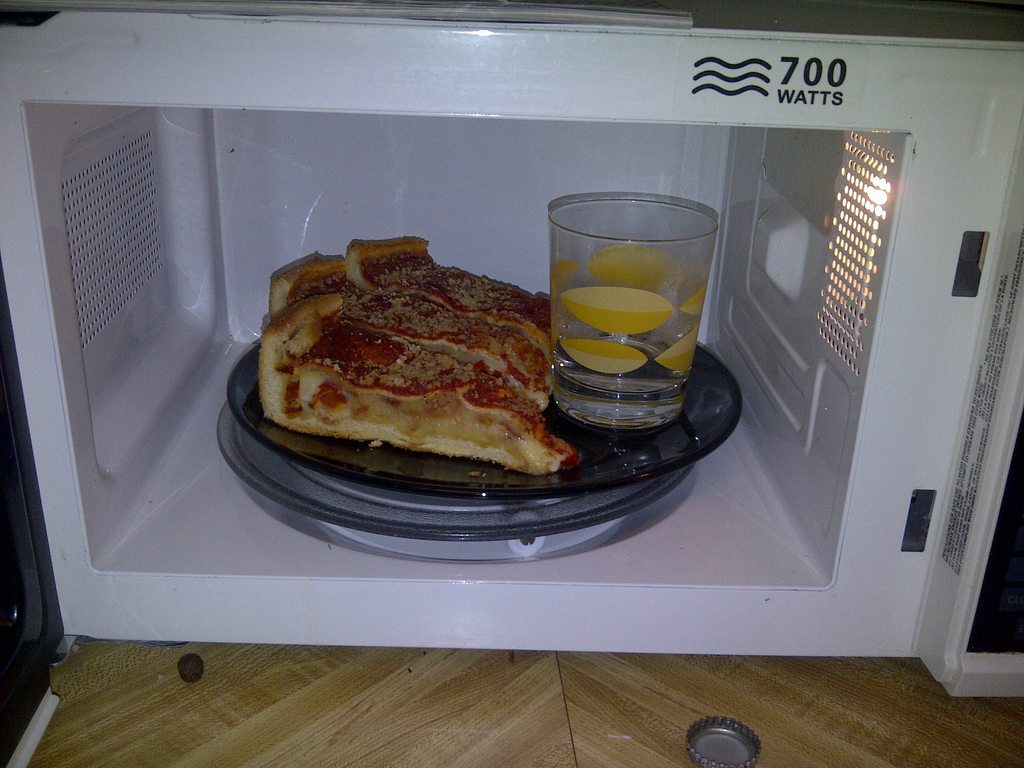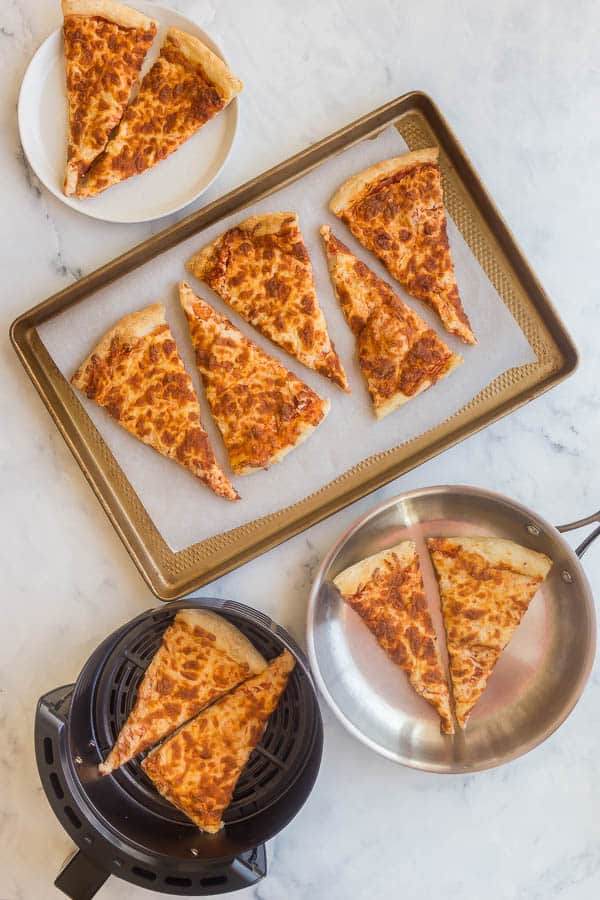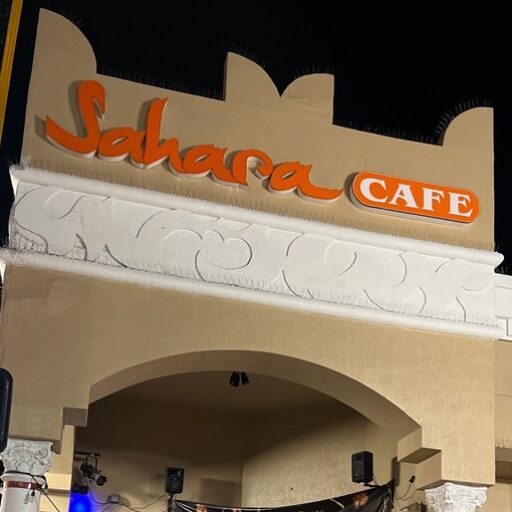Introduction
Overview Of Reheating Pizza In The Microwave
Reheating leftover pizza in the microwave is a convenient and quick way to enjoy your favorite slices again. By following a simple process, you can retain the crispy crust and warm toppings, making it feel like a fresh slice.
To reheat pizza in the microwave, you can use a cup of water to prevent the slices from becoming soggy. This method involves placing a cup of water in the microwave alongside the pizza and heating it in short bursts of around 30 seconds until it reaches the desired temperature.
Advantages And Disadvantages Of Using The Microwave
Using the microwave to reheat pizza offers numerous advantages, including:
- Quick and efficient: Microwaves heat food much faster than ovens, making it a time-saving option for reheating pizza.
- Versatile: Microwaves are suitable for reheating all types of pizza, regardless of the toppings or crust.
- Even heating: With the proper technique, microwaves can evenly heat the pizza, ensuring that each slice is warmed throughout.
However, there are also a few disadvantages to using the microwave for reheating pizza:
- Potential sogginess: If not careful, microwaving pizza can result in soggy crusts or toppings due to the moisture released during heating.
- Texture changes: The microwave may alter the texture of certain toppings or crusts, making them less crisp or crunchy.
In conclusion, reheating pizza in the microwave can be a convenient way to enjoy leftover slices without compromising too much on taste and texture. By following the proper technique and using appropriate settings, you can achieve satisfying results.
Prepping The Pizza
Choosing The Right Microwavable Plate
To effectively reheat pizza in the microwave, it’s important to select a microwavable plate that can withstand the heat. Look for plates that are labeled as microwave-safe to ensure they won’t warp or release any harmful substances during the heating process. Using a microwave-safe plate will help you achieve better results and prevent any potential hazards.
Arranging The Pizza On The Plate For Even Heating
When preparing the pizza for reheating, it’s crucial to arrange the slices properly on the plate. This will promote even heating and prevent any areas from becoming overly hot or cold. Ensure that the slices are uniformly spaced and not overlapping each other. This allows the microwave to distribute heat more evenly and ensures that every bite will be warm and delicious.
Once you have chosen the right plate and arranged the pizza slices, you’re ready to move on to the actual reheating process. By following these prepping steps, you can significantly improve the outcome of reheating pizza in the microwave.

Adding Moisture
The Importance Of Adding Moisture To Retain Pizza’s Moisture
To prevent the pizza from becoming dry and rubbery while reheating in the microwave, it’s crucial to add moisture. Adding moisture helps to retain the pizza’s original texture and juiciness. Without moisture, the reheated pizza can end up being tough and unappetizing. Therefore, it’s important to take this step seriously to achieve the best results.
Using A Cup Of Water To Maintain The Crust’s Texture
One way to add moisture during the reheating process is by placing a cup of water in the microwave alongside the plate of pizza. The water helps to direct moisture away from the pizza, ensuring that it doesn’t absorb excess water and become soggy. This technique also promotes even heating and can help achieve a crispier crust.
By strategically positioning the cup of water next to the pizza, you create a barrier that redirects moisture away from the slices. This method can lead to a more enjoyable reheated pizza with a crispy crust and melted cheese, without sacrificing the original flavors.
Adding moisture during the reheating process is a simple yet effective technique that can make a significant difference in the final outcome of your reheated pizza in the microwave. It’s worth the extra step to ensure a delicious result.
Adding Moisture
The importance of adding moisture to retain the pizza’s moisture
To prevent the pizza from becoming dry and rubbery while reheating in the microwave, it is crucial to add moisture. Adding moisture helps to retain the pizza’s original texture and juiciness. Without moisture, the reheated pizza can end up being tough and unappetizing. Therefore, it is important to take this step seriously to achieve the best results.
Using a cup of water to maintain the crust’s texture
One way to add moisture during the reheating process is by placing a cup of water in the microwave alongside the plate of pizza. The water helps to direct moisture away from the pizza, ensuring that it does not absorb excess water and become soggy. This technique also promotes even heating and can help achieve a crispier crust.
By strategically positioning the cup of water next to the pizza, a barrier is created that redirects moisture away from the slices. This method can lead to a more enjoyable reheated pizza with a crispy crust and melted cheese, without sacrificing the original flavors.
Adding moisture during the reheating process is a simple yet effective technique that can make a significant difference in the final outcome of reheated pizza in the microwave. It is worth the extra step to ensure a delicious result.
Reheating Process
Microwaving in short intervals for even heating
When reheating pizza in the microwave, it is best to do it in short intervals instead of setting a long cooking time. Starting with 30 seconds and checking the slices after each interval is recommended. Depending on the microwave’s power, it may take anywhere from 30 seconds to a minute to fully reheat the pizza.
Tips for preventing the cheese from becoming too hot
After each interval, check if the pizza is heated through. If not, continue reheating in shorter intervals until the cheese is melted and the crust is crispy. This will help ensure that the cheese does not become too hot and lose its gooey texture.
By following these steps, you can enjoy a reheated pizza with a crispy crust and perfectly melted cheese. Remember to allow the pizza to cool to a reasonable temperature before digging in.
Testing For Doneness
How To Check If The Pizza Is Reheated Thoroughly
To determine if the pizza slices are reheated thoroughly, carefully touch the surface of the pizza with your finger. The pizza should feel hot to the touch, indicating that it is heated through. Alternatively, you can also insert a small knife or fork into the center of a slice and check if it comes out hot. These methods will help ensure that the pizza is evenly heated and ready to be enjoyed.
Avoiding Overcooking Or Undercooking The Pizza
It is important to find the right balance when reheating pizza in the microwave. Overcooking the pizza can cause the cheese to become overly melted and the crust to become too crispy or even burnt. On the other hand, undercooking the pizza will leave it cold in the center. To avoid these issues, be sure to check the pizza after each interval and adjust the reheating time accordingly. With practice, you will be able to find the perfect timing for your microwave and achieve a deliciously reheated pizza every time.

Allowing For Cooling
Reasons To Let The Pizza Cool Before Eating
There are a few reasons why it is important to let the pizza cool down slightly before enjoying it:
- Allowing the toppings to cool down slightly makes it easier to enjoy without burning your mouth.
- Cooling the pizza also helps to prevent any further melting of the cheese, maintaining its texture and taste.
Preventing Burns And Enhancing The Overall Taste
By allowing the pizza to cool, you can prevent burns on your mouth from hot toppings or cheese. This step is especially beneficial if you are reheating a pizza with toppings that retain heat, such as meats or vegetables.
Additionally, letting the pizza cool slightly can enhance the overall taste. The flavors of the toppings and crust have time to meld together, creating a more enjoyable eating experience.
Allowing For Cooling
Reasons To Let The Pizza Cool Before Eating
There are a few reasons why it is important to let the pizza cool down slightly before enjoying it:
- Allowing the toppings to cool down slightly makes it easier to enjoy without burning your mouth.
- Cooling the pizza also helps to prevent any further melting of the cheese, maintaining its texture and taste.
Preventing Burns And Enhancing The Overall Taste
By allowing the pizza to cool, one can prevent burns on their mouth from hot toppings or cheese. This step is especially beneficial when reheating a pizza with toppings that retain heat, such as meats or vegetables.
Additionally, letting the pizza cool slightly can enhance the overall taste. The flavors of the toppings and crust have time to meld together, creating a more enjoyable eating experience.
Garnishing Options
Decorating The Reheated Pizza With Fresh Toppings
Reheating pizza provides an opportunity to add fresh garnishes and toppings to enhance its flavors and presentation. Here are some options to consider:
- Sprinkle freshly chopped herbs such as basil, oregano, or parsley over the reheated pizza to add a burst of freshness.
- Drizzle a high-quality olive oil or balsamic glaze over the pizza for added richness and depth of flavor.
- Add sliced cherry tomatoes or roasted red peppers for a pop of color and juiciness.
- Top the pizza with arugula or baby spinach for a touch of green and a hint of bitterness.
Enhancing The Flavors And Presentation
In addition to fresh toppings, there are other ways to enhance the flavors and presentation of reheated pizza:
- Toast the reheated pizza in a preheated oven or a skillet for a few minutes to regain some of its original crispiness.
- Serve the pizza on a wooden or ceramic platter to elevate its visual appeal.
- Sprinkle grated Parmesan or Romano cheese over the pizza to add extra savory notes.
- Garnish with a drizzle of hot sauce or honey for a touch of heat or sweetness, depending on your preference.
By garnishing your reheated pizza with fresh toppings and paying attention to its presentation, you can take your leftovers to the next level and enjoy a delicious meal. Remember to let the pizza cool slightly before garnishing it to preserve its flavors and prevent any burns.
Alternative Reheating Methods
Exploring Other Methods Besides Microwave Reheating
While reheating pizza in the microwave is quick and convenient, there are other methods that can result in a crispier crust and more evenly melted cheese:
- Oven: Preheat your oven to around 375°F (190°C). Place the pizza directly on the oven rack or on a baking sheet lined with parchment paper. Bake for about 10-15 minutes or until the crust becomes crispy and the cheese is melted.
- Skillet: Heat a skillet over medium-low heat. Place the pizza slice(s) in the skillet and cover with a lid. Cook for about 3-5 minutes until the bottom of the crust becomes crispy and the cheese melts. This method is great if you prefer a stovetop option.
Oven And Stovetop Options For Crispy Pizza
Using the oven or stovetop allows the pizza to regain its original crispy texture while also ensuring a more even heat distribution. This can result in a more enjoyable eating experience with a crust that is both crunchy and chewy.
Keep in mind that these alternative methods may take a bit more time and effort compared to using the microwave, but the results can be well worth it. Experiment with different methods to find your preferred way to reheat pizza and achieve that perfect crispy crust.
Alternative Reheating Methods
Exploring Other Methods Besides Microwave Reheating
While reheating pizza in the microwave is quick and convenient, there are other methods that can result in a crispier crust and more evenly melted cheese:
- Oven: Preheat the oven to around 375°F (190°C). Place the pizza directly on the oven rack or on a baking sheet lined with parchment paper. Bake for about 10-15 minutes or until the crust becomes crispy and the cheese is melted.
- Skillet: Heat a skillet over medium-low heat. Place the pizza slice(s) in the skillet and cover with a lid. Cook for about 3-5 minutes until the bottom of the crust becomes crispy and the cheese melts. This method is great if a stovetop option is preferred.
Oven And Stovetop Options For Crispy Pizza
Using the oven or stovetop allows the pizza to regain its original crispy texture while also ensuring a more even heat distribution. This can result in a more enjoyable eating experience with a crust that is both crunchy and chewy.
Keep in mind that these alternative methods may take a bit more time and effort compared to using the microwave, but the results can be well worth it. Experiment with different methods to find your preferred way to reheat pizza and achieve that perfect crispy crust.
Conclusion
Recap Of The Microwave Reheating Process
To recap, here are the steps for reheating pizza in a microwave:
- Place a microwave-safe plate or paper towel on the microwave turntable.
- Arrange the pizza slices on the plate. Make sure they are evenly spaced and not overlapping.
- Place a microwave-safe cup or bowl filled with water in the microwave alongside the pizza. This helps to prevent the crust from becoming rubbery.
- Set the microwave on medium power and heat the pizza for 45 seconds to 1 minute per slice.
- Check if the cheese is melted and the pizza is heated through. If not, continue microwaving in 15-second intervals until desired temperature is reached.
- Once heated, carefully remove the plate from the microwave using oven mitts or a towel.
- Let the pizza rest for a minute or two before enjoying.
Final Thoughts And Recommendations
Reheating pizza in a microwave can be a quick and convenient way to enjoy leftover slices. However, for those who prefer a crispier crust and evenly melted cheese, alternative methods such as using the oven or skillet can provide better results.
Experiment with different reheating methods to find the one that suits your preference and enjoy your reheated pizza as if it were fresh from the oven.
Frequently Asked Questions: How to Reheat Pizza Using the Microwave
Q: Can you reheat pizza in the microwave?
Yes, you can absolutely reheat pizza in the microwave. It’s a quick and convenient method to warm up leftover pizza slices.
Q: How do I reheat pizza in the microwave?
Here’s a simple step-by-step guide to reheating pizza using a microwave:
- Place the pizza slice(s) on a microwave-safe plate. Make sure there is enough space between the slices for even heating.
- If you prefer a softer crust, cover the plate with a microwave-safe lid or a microwave-safe paper towel to retain moisture. This step is optional, but it can help prevent the crust from becoming too crispy.
- Set your microwave to medium or medium-high heat. High heat can cause the pizza to become less crispy, so a moderate setting is recommended.
- Microwave the pizza for around 1-2 minutes, depending on your microwave’s power level and the thickness of the pizza slice(s). If you have multiple slices, you may need to increase the cooking time slightly.
- After the initial heating, check the pizza’s temperature and consistency. If it’s not fully heated through, microwave it in additional 30-second intervals until it reaches the desired level of warmth.
- When the pizza is heated thoroughly, carefully remove the hot plate from the microwave using oven mitts or a kitchen towel. Let it cool down for a minute or so before enjoying.
Q: How long does it take to reheat pizza in the microwave?
The reheating time can vary depending on factors such as the thickness of the pizza slice(s) and the power level of your microwave. In general, it usually takes around 1-2 minutes to reheat a single slice of pizza using medium or medium-high heat.
Q: Can I microwave cold pizza straight from the fridge?
Yes, you can microwave cold pizza straight from the fridge. However, keep in mind that the reheating time may be slightly longer than if the pizza slice(s) were at room temperature. It’s generally recommended to let the pizza sit at room temperature for a few minutes before microwaving to ensure even heating.
Q: Can I reheat a whole pizza in the microwave?
Reheating a whole pizza in the microwave is not recommended due to the size and thickness. The heat distribution might be uneven, resulting in some parts being overcooked while others remain cold. It’s best to reheat individual slices separately for optimal results.
Q: Will reheating pizza in the microwave make it soggy?
The microwave can make the pizza texture slightly softer, including the crust. However, using a microwave-safe lid or a microwave-safe paper towel to cover the plate can help retain moisture and prevent excessive sogginess. Adjusting the heating time and power level can also help avoid any unwanted sogginess.
Remember, microwaving is a convenient method for reheating pizza, but if you prefer a crispy crust, other methods like using the oven or stovetop may yield better results.

Welcome to Sahara Cafe Hollywood, the best Latin food restaurant in Hollywood, Florida! Our journey began with a passion for bringing Latin cuisine’s vibrant flavors to Hollywood’s heart. Located at 2000 Harrison St, Suite 1, Hollywood, FL 33020, United States, Sahara Cafe has become a beloved culinary destination for locals and visitors alike. Since our establishment, Sahara Cafe Hollywood has been dedicated to delivering an authentic and memorable dining experience. Every dish we create reflects our commitment to serving the finest Latin cuisine. From sizzling fajitas to mouthwatering empanadas, each item on our menu is crafted with the freshest ingredients and traditional recipes that capture the essence of Latin American culinary heritage.